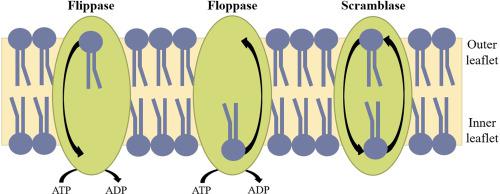Biochimica et Biophysica Acta (BBA) - Biomembranes ( IF 2.8 ) Pub Date : 2020-06-06 , DOI: 10.1016/j.bbamem.2020.183382 R J Clarke 1 , K R Hossain 2 , K Cao 2

|
The plasma membrane phospholipid distribution of animal cells is markedly asymmetric. Phosphatidylserine (PS) and phosphatidylethanolamine (PE) are concentrated in the inner leaflet, whereas phosphatidylcholine (PC) and sphingomyelin (SM) are concentrated in the outer leaflet. This non-equilibrium situation is maintained by lipid pumps (flippases or floppases), which utilize energy in the form of ATP to translocate lipids from one leaflet to the other. Scramblases, which are activated when physiologically required, transport lipids in both directions across the membrane and can abolish lipid asymmetry. Lipid asymmetry also causes imbalances in the areas occupied by lipid in the two membrane leaflets, contributing to membrane curvature. The asymmetry of PS across the plasma membrane plays a crucial signalling role in numerous physiological processes. Exposure of PS on the external surface of blood platelets stimulates blood coagulation. PS exposure by other cells during apoptosis provides an “eat me” signal to surrounding macrophages. Many peripheral and integral membrane proteins have polybasic PS-binding domains on their cytoplasmic surfaces which either provide a membrane anchor or affect activity. These domains can also determine trafficking within the cell and control regulation via an electrostatic switch mechanism, as well as potentially acting as “death sensors” when cytoplasmic PS is transferred to the extracellular leaflet during apoptosis. Apart from these physiological roles, external PS exposure by microorganisms, viruses and cancer cells allows them to mimic the immunosuppressive anti-inflammatory action of apoptotic cells and proliferate, thus providing a strong medical motivation for future research in the field of lipid asymmetry in membranes.
中文翻译:

动物膜的横向脂质不对称的生理作用。
动物细胞的质膜磷脂分布明显不对称。磷脂酰丝氨酸(PS)和磷脂酰乙醇胺(PE)浓缩在内部小叶中,而磷脂酰胆碱(PC)和鞘磷脂(SM)浓缩在外部小叶中。这种非平衡状态由脂质泵(脂肪酶或软蛋白酶)维持,脂质泵利用ATP形式的能量将脂质从一个小叶转移到另一个小叶。在生理上需要时会被激活的Scramblases在两个方向上跨膜运输脂质,并可以消除脂质不对称性。脂质不对称还导致两个膜小叶中脂质占据的区域不平衡,从而导致膜曲率。PS在质膜上的不对称性在许多生理过程中起着至关重要的信号作用。PS暴露于血小板外表面会刺激血液凝结。凋亡期间其他细胞的PS暴露会向周围的巨噬细胞提供“吞噬”信号。许多外周膜和整合膜蛋白在其细胞质表面具有多价PS结合结构域,可提供膜锚或影响活性。这些结构域还可以确定细胞内的运输并通过静电开关机制控制调节,以及在细胞凋亡过程中将胞质PS转移至细胞外小叶时潜在地充当“死亡传感器”。除了这些生理作用外,微生物通过外部PS暴露,











































 京公网安备 11010802027423号
京公网安备 11010802027423号